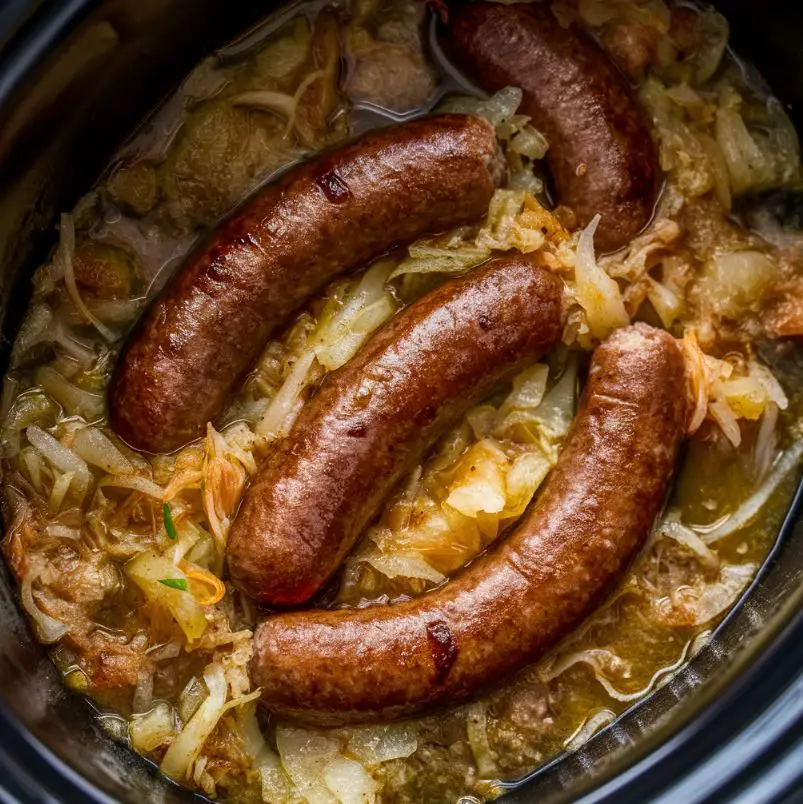Introduction
Sausage and sauerkraut present a delightful combination that has stood the test of time, particularly in German cuisine. This classic dish is cherished for its comforting, hearty nature and its harmonious blend of flavors. The savory, juicy sausages paired with the tangy bite of sauerkraut create a meal that is not only satisfying but also deeply rooted in cultural traditions.
Originating from Germany, sausage and sauerkraut have become synonymous with Oktoberfest celebrations and hearty home-cooked meals. Over the years, this dish has transcended borders, finding its way into the hearts and kitchens of food enthusiasts worldwide. The simplicity of its preparation adds to its appeal, making it an ideal choice for both novice cooks and seasoned chefs looking for a quick yet delicious meal.
The beauty of sausage and sauerkraut lies in its versatility. From the choice of sausages—whether it be bratwurst, kielbasa, or Italian sausage—to the type of sauerkraut used, there are numerous variations to suit different tastes and preferences. This blog post aims to guide you through all the nuances of making this classic dish. We will provide a detailed recipe, explore various adaptations, offer valuable tips, and address frequently asked questions to ensure your sausage and sauerkraut experience is as enjoyable and flavorful as possible.
Whether you’re a fan of traditional German fare or simply in search of a reliable, comforting meal, sausage and sauerkraut is a dish worth trying. As we delve into the specifics of preparing this culinary gem, you’ll find that it combines ease with taste, making it a perfect addition to your recipe repertoire. Join us as we explore what makes sausage and sauerkraut a timeless favorite and how you can effortlessly recreate it in your own kitchen.
Ingredients Needed
To prepare a delightful dish of sausage and sauerkraut, it is imperative to gather the finest and freshest ingredients. Here is a comprehensive list that ensures a robust and flavorful meal:
First, select your sausages. While bratwurst and kielbasa are the most traditional options, you can also experiment with varieties such as Italian or smoked sausages to add a unique twist to the dish. Opt for high-quality sausages from reputable sources to ensure a succulent and savory result.
Next, the sauerkraut is equally essential. Whether you prefer homemade or store-bought, authenticity is key. Look for sauerkraut that is naturally fermented with a briny, tangy taste. This fermentation process is not only beneficial for your gut health but also significantly enhances the overall flavor profile of the dish.
For additional depth and complexity, consider incorporating optional add-ins. Sliced onions lend a sweet and aromatic nuance when sautéed, while potatoes provide a hearty and comforting element. You may also add apples for a subtle sweetness that contrasts beautifully with the tangy sauerkraut. Russet or Yukon gold potatoes are ideal choices for their ability to hold their shape during cooking, and varieties like Granny Smith apples are perfect for their crisp texture and tart flavor.
Finally, a few key seasonings will enhance the dish further. Caraway seeds add a warm, earthy flavor that complements the sauerkraut and sausage perfectly. Freshly ground black pepper and salt, to taste, will help balance the spices and bring out the natural flavors of the ingredients.
Ensuring each component is of top-notch quality is fundamental. Freshness and authenticity transform a simple meal into an exceptional culinary experience, making sausage and sauerkraut a standout dish on any table.
Step-by-Step Recipe Instructions
Creating the perfect sausage and sauerkraut dish involves a few straightforward steps that ensure the best flavor and texture. This detailed guide takes you from preparing the ingredients to plating the final meal, ensuring superior results each time.
Step 1: Gather Your Ingredients
Before you begin cooking, ensure you have all necessary ingredients at hand:
- 1 lb of sausage (kielbasa, bratwurst, or your preferred type)
- 2 cups of sauerkraut, drained
- 1 medium onion, thinly sliced
- 2 cloves of garlic, minced
- 1 tablespoon of caraway seeds
- 1 cup of apple cider or chicken broth
- 1 tablespoon of vegetable oil
- Salt and pepper to taste
- Fresh parsley for garnish (optional)
Step 2: Prepping the Ingredients
Start by cutting the sausage into bite-sized pieces. This will ensure even cooking and make the dish easier to eat. Thinly slice the onion and mince the garlic to release their flavors fully during cooking. Drain the sauerkraut, but do not rinse it, as the residual brine adds to the dish’s complexity.
Step 3: Sautéing the Sausage
Heat the vegetable oil in a large skillet or Dutch oven over medium heat. Once the oil is hot, add the sausage pieces. Brown them on all sides, allowing the natural fats to render and impart flavor to the oil. This should take about 5-7 minutes. Once done, remove the sausage from the skillet and set it aside.
Step 4: Cooking the Vegetables
In the same skillet, add the sliced onions and cook until they become translucent, about 5 minutes. Add the minced garlic and cook for another minute, being cautious not to burn the garlic as it can become bitter. Add the caraway seeds and stir for another minute to release their aroma.
Step 5: Combining the Ingredients
Return the sausage to the skillet with the onions and garlic. Pour in the apple cider or chicken broth until it nearly covers the sausage and vegetables. Add the drained sauerkraut to the skillet, stirring gently to combine all ingredients. Season with salt and pepper, but keep in mind that sauerkraut can be quite salty, so adjust accordingly.
Step 6: Simmering
Reduce the heat to low and cover the skillet. Allow the mixture to simmer for about 20-30 minutes. During this time, the flavors will meld together, and the sausage will become tender. Stir occasionally to ensure even cooking and to prevent anything from sticking to the bottom of the skillet.
Step 7: Final Touches
After simmering, taste the dish and adjust the seasoning if necessary. If you prefer a less tangy flavor, you can add a small amount of sugar to balance the acidity of the sauerkraut. For an added touch, garnish with fresh parsley before serving.
Common Mistakes to Avoid
Using too much heat: Cooking over high heat can cause the sausages to dry out and the sauerkraut to become overly soft and mushy. Maintain a medium to low heat throughout the cooking process.
Neglecting the liquid balance: Ensure there is enough liquid (apple cider or broth) to prevent the dish from drying out but not so much that it becomes soupy. It should have a slightly moist texture.
Skipping the simmering step: Simmering is crucial for melding flavors and achieving the desired tenderness in both the sausage and sauerkraut. Patience during this step guarantees the best results.
With these comprehensive instructions, you can confidently prepare a delectable sausage and sauerkraut meal that’s perfect for any occasion. Enjoy the harmonious blend of savory and tangy flavors in every bite.
Variations and Add-Ons
The beauty of the sausage and sauerkraut dish lies not only in its simplicity but also in the myriad of ways it can be customized to suit individual tastes and preferences. One of the most popular variations includes adding potatoes, which significantly enhances the heartiness of the meal. Potatoes can be diced or sliced and roasted along with the sausages and sauerkraut. They absorb the savory flavors of the sausages and the tangy notes of the sauerkraut, creating a more filling and satisfying dish.
When it comes to sausages, the options are nearly endless. Traditional pork sausages are often used, but experimenting with different types such as bratwurst, kielbasa, or even chicken sausages can bring new dimensions to the dish. Each variety of sausage introduces unique flavors and textures, from the mild and delicate taste of chicken sausages to the strong, robust flavor of bratwursts. Moreover, smoked sausages add an extra layer of depth with their smoky undertones.
Incorporating different spices is another excellent way to tailor this recipe. Adding caraway seeds can provide a distinct, earthy flavor that complements the sauerkraut wonderfully. A sprinkle of paprika can introduce a hint of smokiness and color, while a touch of hot pepper flakes can bring the dish to life with a little kick. The spices can be adjusted to fit your desired level of flavor and heat.
An unexpected but delightful addition to this recipe is apples. Adding sliced apples introduces a subtle sweetness that balances the acidity of the sauerkraut. Apples can also soften as they cook, contributing to a variety of textures in the final dish. Granny Smith or Honeycrisp apples work particularly well due to their firm texture and tart flavor.
These variations and add-ons not only diversify the sausage and sauerkraut recipe but also allow for a personalized culinary experience, ensuring that each bite is uniquely flavorful and enjoyable.
When perfecting your sausage and sauerkraut dish, the selection of ingredients and cooking techniques make all the difference. Starting with the sausage, choose high-quality options such as bratwurst, kielbasa, or smoked sausages. These varieties have robust flavors that complement the tanginess of sauerkraut. Remember that artisanal sausages made by local butchers often have superior taste and texture compared to mass-produced counterparts.
Next, consider making your own sauerkraut. Homemade sauerkraut not only allows for control over the levels of tanginess but also permits customization with spices like caraway seeds, juniper berries, and bay leaves. The fermentation process is straightforward; simply shred fresh cabbage, mix it with salt, and let it ferment in a clean, sealed container for a few weeks.
Balancing the flavors is critical in this classic dish. To achieve this, incorporate a touch of sweetness to offset the sour notes of the sauerkraut. Apples, a sprinkling of brown sugar, or a splash of apple cider are excellent additions. Pair these with aromatic ingredients such as onions and garlic for a more complex flavor profile.
Cooking techniques also play a significant role in achieving the perfect sausage and sauerkraut. To avoid sausages drying out or becoming overly greasy, consider simmering them in a bit of beer or broth before browning them in a pan. This method ensures they are cooked through and imbued with added richness.
When it comes to sauerkraut, prevent it from becoming too sour by rinsing the store-bought variety under cold water before cooking. Additionally, cooking sauerkraut gently over low heat can mellow out its tartness without losing its unique zing.
Follow these tips to create a delicious sausage and sauerkraut dish that balances savory, sour, and sweet elements perfectly, delighting your taste buds and those of your guests.
Serving Suggestions and Pairings
When presenting sausage and sauerkraut, consider traditional accompaniments that enhance the flavors and make the dining experience more enjoyable. Mustard, with its tang and heat, is a classic condiment that provides a sharp contrast to the rich and savory sausage. Grainy or Dijon mustard varieties work particularly well. Rye bread is another traditional pairing, adding a hearty texture and nutty undertone that complements the sauerkraut’s acidity.
For side dishes, potatoes in various forms are an excellent choice. Whether it’s mashed, roasted, or boiled, potatoes offer a mellow background that lets the sausage and sauerkraut shine. A potato salad with a light vinaigrette can also add a refreshing element to the meal. Caramelized onions and sautéed apples can bring an unexpected sweetness that balances the dish’s savory and tangy components.
Pairing drinks thoughtfully can elevate the meal further. Beer, especially German varieties like lagers or wheat beers, is a traditional and perfect companion to this dish. Their crisp and sometimes slightly bitter flavors cleanse the palate and enhance the meal’s enjoyment. If you prefer wine, consider a semi-dry Riesling or a light-bodied red like Pinot Noir. The acidity in these wines complements the tangy sauerkraut while their body and flavor profile harmonize with the hearty sausage.
Presentation plays a critical role in making the meal visually appealing. Arrange the sausages on a large platter with the sauerkraut nestled around or beneath them. Garnish with fresh parsley or chives for a pop of color. Serve mustard in small bowls or ramekins to allow for controlled portions. Slices of rye bread can be fanned out on a separate plate, inviting guests to build their own bites. A well-plated sausage and sauerkraut dish not only pleases the palate but also excites the eye, making the dining experience complete.
FAQs About Sausage and Sauerkraut
Can you make sausage and sauerkraut in advance?
Yes, you can absolutely make sausage and sauerkraut in advance. Preparing this dish ahead of time not only saves you effort on the day you plan to serve it but it also allows the flavors to meld together even more. Cook the sausage and sauerkraut according to your recipe and let it cool to room temperature. Then, store it in an airtight container in the refrigerator. It can be kept this way for up to three days without losing its delightful taste and texture.
How do you store and reheat leftovers?
To store leftovers, place them in an airtight container and refrigerate. Sausage and sauerkraut can be kept in the refrigerator for up to three days. When you’re ready to reheat, you have a few options. You can use the microwave, stovetop, or oven. For microwave reheating, place the desired portion in a microwave-safe dish and cover it. Heat on medium power for 2-3 minutes or until warmed through. For stovetop reheating, transfer the leftovers to a pan and heat over medium heat, stirring occasionally, for about 5-7 minutes. If you choose the oven, place the food in an oven-safe dish, cover with foil, and heat at 350°F (175°C) for about 15-20 minutes.
What are some vegan alternatives?
For those who prefer vegan alternatives, there are several options to enjoy the flavors of sausage and sauerkraut without the meat. You can use plant-based sausages, which are available in many supermarkets. Brands like Beyond Meat, Tofurky, and Field Roast offer tasty and satisfying vegan sausages. Another alternative is to make your own vegan sausages using ingredients like seitan or tempeh. Pair these with traditional sauerkraut or even a homemade version which can be made by fermenting cabbage with salt. The cooking process for the vegan options is similar to the traditional recipe, ensuring you still get a hearty and flavorful meal.
Is it possible to freeze sausage and sauerkraut?
Yes, sausage and sauerkraut can be frozen for longer storage. After cooking, let the dish cool completely before transferring it to an airtight container or freezer bag. Store in the freezer for up to three months. When you’re ready to eat, thaw it in the refrigerator overnight and then reheat using your preferred method.
Are there health benefits to eating sauerkraut?
Yes, sauerkraut is not only delicious but also offers several health benefits. It’s a fermented food, which means it’s rich in probiotics—these beneficial bacteria promote a healthy gut. Sauerkraut is also a good source of vitamins C and K, iron, and fiber. These nutrients support overall health, including immune function and digestion.
Conclusion
The sausage and sauerkraut recipe we’ve explored is a testament to the idea that simplicity can yield incredibly delicious results. Throughout this blog post, we highlighted the ease with which you can prepare this time-honored dish, emphasizing its straightforward ingredients and minimal preparation time. By combining flavorful sausages with tangy sauerkraut, you create a harmonious blend that is satisfying and comforting.
This recipe also offers ample room for experimentation. Whether you choose to add herbs, incorporate different types of sausages, or introduce other complementary ingredients, the adaptability of this dish ensures that you can tailor it to your personal taste preferences. The versatility and simplicity make sausage and sauerkraut a wonderful addition to any culinary repertoire.
We encourage you to try this recipe and experience its wonderful flavors for yourself. Whether you are cooking for a family dinner or seeking a quick, delicious meal on a busy night, sausage and sauerkraut is a reliable choice. Please feel free to share your results, ask questions, or provide feedback in the comments section below. Engage with other readers and us to make your cooking journey even more enjoyable.
- Ground Beef and Andouille Sausage Dirty Rice: A Flavorful One-Pot Meal
- Gluten-Free Breakfast Casserole: A Delicious Morning Treat

Sausage and Sauerkraut: A Delicious and Simple Recipe
- Total Time: 40 minutes
Description
Savory Sausage and Sauerkraut!
Hearty sausage meets tangy sauerkraut for a deliciously satisfying meal!
Ingredients
Instructions
- Prep Time: 10 minutes
- Cook Time: 30 minutes
Nutrition
- Serving Size: 4 servings

